Has a problem been found?

Repair as necessary and go to "Verification of Vehicle Repair" procedure.

Go to " Power Circuit Inspection " procedure.
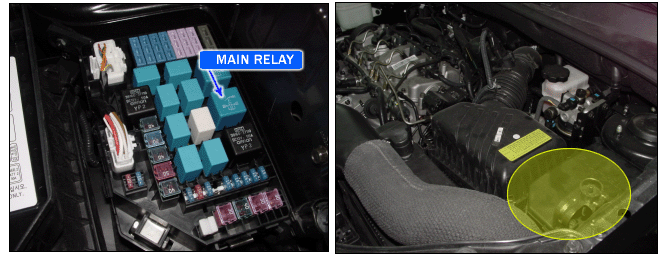
The voltage after the main relay is used to supply power to the sensors and actuators.
ECM controls the main relay and its remains ON at key OFF in order to store the adaptaion values and fault status to the memory.
When the ignition switch is turned ON, current flows from the ignition switch through the current and the main relay coil to ground by the ECM.
And then, the voltage is supplied to the sensors and actuators to drive.
In case of the the main relay failure, the engine symptoms will occur a running engine stall, a starting impossible and glow plug deactivation.
If the signal exceeds threshold value, the ECM judged this as a fault and DTC is set.
Item | Detecting Condition | Possible Cause |
DTC Strategy | ● Circuit continuity check | ● Opne or short in power circuit ● Open or short in relay control circuit ● Faulty relay ● Faulty ECM |
Enable Conditions | ● Ignition on and off | |
Threshold Value | ● main relay shut off time is too early or late when comeparing the ignition on/off time with the ECM microcomputer signal. | |
Diagnostic Time | ● 0 sec. | |
MIL Fuel Limit Fuel Cut EGR Off | ● Yes ● No ● No ● No | |
Fail safe | ● EGR valve deactivited ● Fuel quantity limitation |
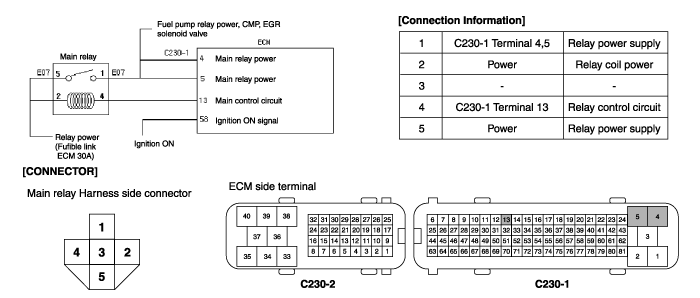
Many malfunctions in the electrical system are caused by poor harness and terminals.
Faults can also be caused by interference from other electrical systems, and mechanical or chemical damage.
Thoroughly check connectors for looseness, poor connection, bending, corrosion, contamination, deterioration, or damage.
Has a problem been found?

Repair as necessary and go to "Verification of Vehicle Repair" procedure.

Go to " Power Circuit Inspection " procedure.
Ignition "OFF" & Engine "OFF".
Disconnect Main Relay.
Ignition "ON" & Engine "OFF".
Measure voltage between terminal 2 of the main relay harness connector and chassis ground.
Measure voltage between terminal 5 of the main relay harness connector and chassis ground.
Specification : B+
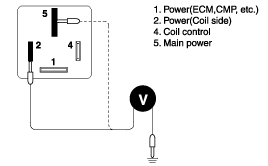
Is the measured voltage within specifications ?

▶ Go to "Control Circuit Inspection" procedure.

▶ Check for open or short in the power harness.
Repair as necessary and go to "Verification of Vehicle Repair" procedure.
Check for short to ground in harness.
Ignition "OFF".
Disconnect Main relay.
Measure resistance between terminal 4 of the Main relay harness connector and chassis ground.
Specification : Infinite
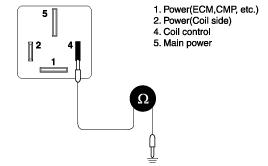
Is the measured resistance within specifications ?

▶ Go to "Check for short to battery in harness" as below.

▶ Check for short to ground in harness.
Repair as necessary and go to "Verification of Vehicle Repair" procedure.
Check for short to battery in harness.
Ignition "OFF".
Disconnect Main relay.
Ignition "ON" & Engine "OFF".
Measure voltage between terminal 4 of the Main relay harness connector and chassis ground.
Specification : Approx. below 1V
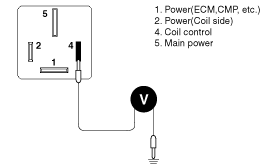
Is the measured resistance within specifications ?

▶ Go to "Check for open in harness " as below.

▶ Check for short to ground in harness.
Repair as necessary and go to "Verification of Vehicle Repair" procedure.
Check for open in harness.
Ignition "OFF" & Engine "OFF".
Disconnected MAF sensor connector and ECM connector.
Measure resistance between terminal 4 of the Main relay harness connector and terminal 13 of ECM harness connector.
Specification : Approx. below 1Ω
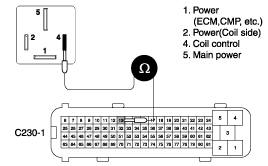
Is the measured resistance within specifications ?

▶ Go to "Component Inspection" procedure.

▶ Check for open in harness.
Repair as necessary and go to "Verification of Vehicle Repair" procedure.
Check Main relay.
Ignition "OFF" & Engine "OFF".
Disconnect Main relay.
Measure resistance between terminal 2 and 4 of main relay (Component side).
Specification : 70 ~ 90Ω (20°C)
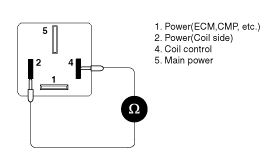
Is the measured resistance within specifications ?

▶ Go to "Check Main relay operation " as below.

▶ Substitute with a known-good Main relay and check for proper operation.
If the problem is corrected, replace main relay and then go to "Verification of Vehicle Repair" procedure.
Check Main relay operation.
Ignition "OFF" & Engine "OFF".
Connect Main relay and Disconnect ECM connector.
Connect volt meter or test lamp with terminal 4 and 5 of ECM harness connector.
Ignition "ON" & Engine "OFF".
Ground terminal 13 of ECM harness connector so that Main relay operates. Or,
Connect ECM harness connector and then, check that main relay operates if 12V is detected at terminal 58 of ECM connector after Ignition ON.
Is the 12V detected on voltmeter with operating main relay ?

▶ Thoroughly check connectors for looseness, poor connection, bending, corrosion, contamination, deterioration, or damage. Repair or replace as necessary and go to "Verification of Vehicle Repair" procedure.

▶ Substitute with a known-good ECM and check for proper operation.
If the problem is corrected, replace ECM and then go to "Verification of Vehicle Repair" procedure.
After a repair, it is essential to verify that the fault has been corrected.
Connect scan tool and select "Diagnostic Trouble Codes(DTCs)" mode and then clear DTC.
Operate the vehicle within DTC Enable conditions in General information.
Are any DTCs present ?

Go to the applicable troubleshooting procedure.

System is performing to specification at this time.